|
Already in danger of flogging its classic monsters to death by the late 1960s, Britain's Hammer Studios began looking for alternative source material for potentially profitable movie updates. It struck gold in 1966 with One Million Years B.C., a remake of the 1940 Hal Roach Studios produced prehistoric fantasy adventure, One Million B.C.. Like the original, it paid little heed to the known facts and threw dinosaurs and well-groomed humans into the same movie, despite the former having become extinct millions of years before the latter evolved. It did take a chance by having no comprehensible dialogue, but story and conversation were never its raison d'être. The monsters were the draw here, the best of which were stop motion creations by the great Ray Harryhausen, but the real selling point was the now iconic image of its glamorous star, Rachel Welch, dressed in a fur bikini. This became the basis for the film's publicity material, and as a stand-alone pinup poster it sat proudly on many a boy's bedroom wall in its day. No-one cared that the cavemen were Caucasian and the women had permed hair, and the film went on to make a very decent profit. Further Cave Girl projects inevitably soon followed. Welch's One Million Years B.C. co-star, Martine Beswick, dominated the now little-discussed Prehistoric Women (1967, aka Slave Girls), but the first film's true spiritual successor came in 1970 in the shape of the Val Guest directed When Dinosaurs Ruled the Earth, whose stop motion effects were the work of Jim Danforth and apparently complex and time-consuming enough to delay the film's release. Word is that even before the effects work on this film was complete, preproduction had begun on a fourth Cave Girl film, one whose budget and tight schedule did not allow for the sort of effects work that were one of the major attractions of One Million Years B.C. and When Dinosaurs Ruled the Earth. Once again Hammer had found a curvaceous female beauty on whom to market the film in shape of former Miss Norway, Julie Ege, but this time there were to be no dinosaurs and a determination by writer-producer Michael Carreras to bring a degree of realism to a subgenre with firmly fantastical roots.
Creatures the World Forgot is in some ways an unusual film for Hammer, despite being essentially the fourth entry in a largely successful series. As Kim Newman and Sean Hogan make clear on the commentary track, the absence of dinosaurs disappointed audience expectations on the film's release, and you could argue that it seems to welch on a title that seems to promise them aplenty. In common with its predecessors, there is no comprehensible dialogue, which here is confined to primordial grunts, screams and shouts, with gestures being the principal method of communication. The costumes also have a more handmade and practical feel, and the unkempt hairstyles look more convincingly shaped by the environment and unchecked natural growth than in the earlier movies. In addition, the film was shot primarily on location in Namibia against expansive and landscapes that genuinely feel hostile to human survival, and while the casting of Caucasian actors was somewhat inevitable, they at least have skin that looks convincingly tanned by long days in the burning sun. It's likely that the Dawn of Man prologue from 2001: A Space Odyssey was an influence here, but for an early 1970s Hammer movie, the air of authenticity this collectively creates is genuinely disarming. The story, meanwhile, though every bit as simplistic as those of its forebears, gets ambitious with this timespan and includes three time uncaptioned time jumps of several years apiece. Where this comes close to tripping the film up is that the first 50 minutes of this 96 minute film are effectively a prologue to a story that doesn't really get going until well past the halfway mark.
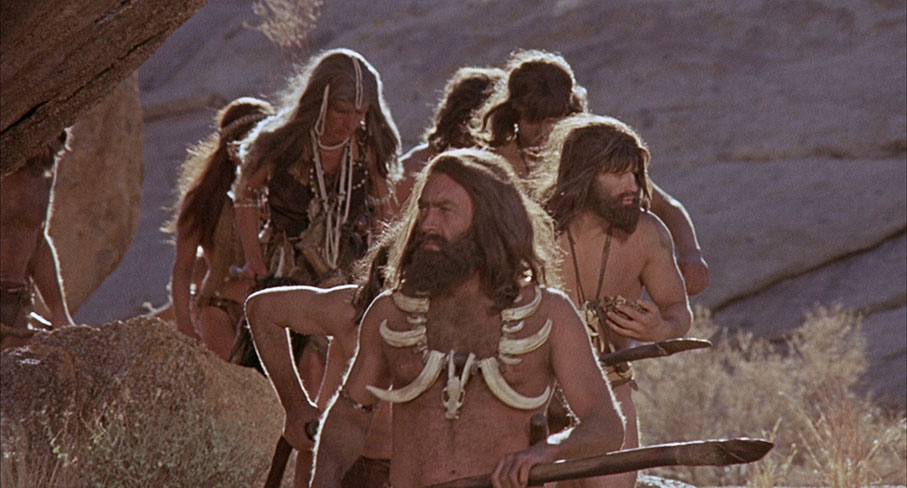
The film begins with a tribal hunting party killing an antelope, only for its mate to then charge one of the tribesman, who dies after being gored by the animal's horns. He is hastily buried by his fellow hunters, who first remove his bone necklace to present to his mate* when they make their triumphant return to home base with this new source of food. When a volcano eruption wipes out half of the tribe, Mak (Brian O'Shaughnessey)** fights and kills his rival to become its new leader, being officially anointed to the position by the tribal Shaman (Rosalie Crutchley).
Under Mak's leadership, the survivors of the eruption begin an arduous journey across a desert landscape in search of more fertile land, eventually encountering a fair-haired tribe whose leader (Ken Hare) holds a weapon that indicates that they were once coastal dwellers. Potential conflict is avoided when the children of the two tribes quickly bond, and both leaders then pay tribute to the other by presenting them with an attractive young woman from their own tribe with whom to mate. When the young lover of the girl presented to the leader of the fair-haired tribe tries to steal her away, he and the girl are quietly executed, and Mak and his people make their departure. It's then that we get the first of the unannounced time jumps, as the film leaps forward nine months to find Mak's blonde-haired mate giving birth to twin boys, a presumably arduous experience that she does not survive. We then hop forward again a few years, and the fair haired young Toomak (Gerard Bonthuys) and his dark-haired brother Rool (Hans Kiesouw) are now rivals for their father's approval, something that tends to be conferred on the attentive Toomak rather than the spitefully jealous Rool. When we hit the magic 50-minute mark, Toomak (now played by Tony Bonner) and Rool (Robert John) are now young adults and capable warriors, but the rivalry of their childhood has clearly not abated. When Mak eventually dies and the time arrives to appoint a new leader, the conflict between the Toomak and Rool explodes and splits the tribe in two, pitting the bothers and their followers against each other.
Creatures the World Forgot is a curious but nonetheless fascinating beast, a risky piece of experimentation with an established formula that failed to attract much critical praise or set the box office alight, yet all these years later it proves an oddly intriguing and intermittently arresting entertainment. It also, in retrospect, feels like a trial run for Jean-Jacques Annaud's 1981 Quest for Fire, both in the air of authenticity that both films strive for and the more conventional aspects of their respective tribal rivalries. In Creatures, subtlety takes a bit of a back seat on this score, with the handsome, fair-haired and honourable Toomak quickly identified as the good guy (he even has his father's name embedded in his), and the dark-haired, frowny and ill-tempered Rool just as rapidly painted as the villain, and we don't really get to know either of them well enough to really root for them, beyond wanting to see the essentially decent Toomak triumph over his vindictive brother. It doesn't help that we don't even get to meet them in their adult form until the second half, and both are outshone on the acting and character front anyway by Rosalie Crutchley's Shaman (a character rather unkindly credited in the film itself as 'The Old Crone'), whose hyper-aware intensity and long-standing influence within the tribe makes her the film's most quietly compelling character, as well as being its most arrestingly performed. Only later does it emerge that the mute young woman (Marcia Fox) in whom she takes an interest is being quietly groomed to become her successor. It's also suggested that this girl is developing a sixth sense centred around Rool's physical safety, an unexpected but interesting supernatural twist in an otherwise reality-grounded tale. Intriguingly, the film's nominal star, Julie Ege, also doesn't appear and after the halfway mark, and then plays second fiddle to Toomak, who's there to come to her rescue when she is attacked and pnder on the idea of taking her as his mate.
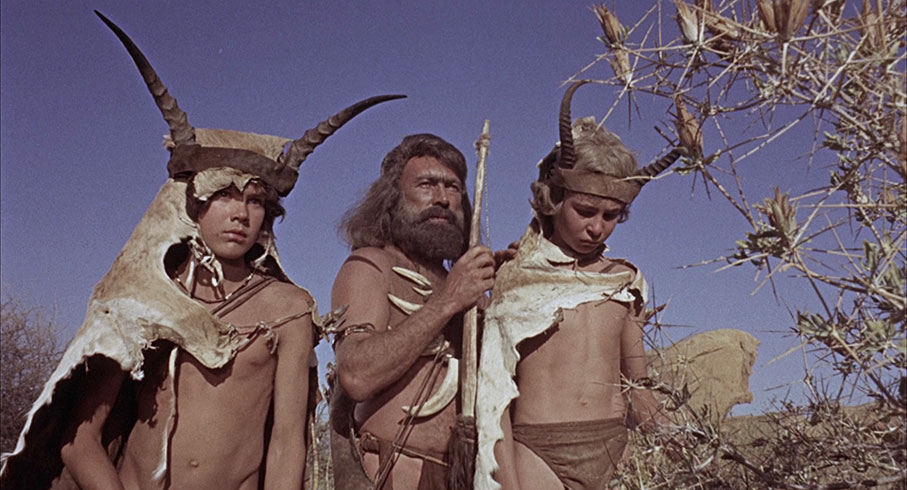
Is it as much fun as One Million Years B.C.? Perhaps not, but it's still far better that its reputation and its curt dismissal in some quarters might suggest, and in its low-key approach and commitment to at least a degree of realism, it occasionally comes close to being the best of the Cave Girl films. It's smartly directed by old hand Don Chaffey, who also helmed One Million Years B.C. and who here gets to flex his cinematic muscles, dwarfing his characters in landscape wides, then moving in close to allow facial expressions to take the place of unspoken words. More adventurous is his use of almost verité-like handheld camerawork, creating the sense at times that events are being captured on the fly by a mobile documentary crew. As in the later Quest for Fire, the landscape plays as important a role as the human characters that exist and move within it, being handsomely framed by Vincent Cox's Technicolor cinematography, which imbues the locations with a sometimes striking sense of scale and danger (there are times in the mountaintop climax when the actors really do look at risk). I'll also give a shout to the intriguing score by Italian composer Mario Nascimbene, who also composed the music for One Million Years B.C. and When Dinosaurs Ruled the Earth, and whose impressive CV includes such diverse titles as Sons and Lovers, Room at the Top and The Vikings.
Anthropologists will still find plenty to scoff at, and the restrictions imposed by the budget and the studio's trademark pragmatism ensure that the realism only goes so far. The violence is convincingly brutal – a late film encounter with a masked tribe is particularly nasty – but quite how the Nordic-looking fair-haired tribe found themselves on the same continent as the dark-haired Mak and his crew is anybody's guess. We can blame the censorship of the day for the film's seemingly schizophrenic approach to nudity, with anything that might land the film an 'X' certificate conveniently covered by animal skins, and while topless females were likely a key selling point, this rarely feels gratuitous. Consistent, however, it is not, and whether a tribeswoman is bare-chested (usually with partially concealing animal jewellery) or wearing an animal-skin brassiere (I hear they were all the rage back then) was probably down to the individual actors and contracts. I'd still argue that Creatures the World Forgot is an undervalued and in some ways refreshingly atypical Hammer work. It's a shame that it wasn't more positively received on its release, as had it been a critical and financial success, who knows what new directions it might have encouraged the studio to later explore.
The 1080p, 1.85:1 transfer on this Indicator Blu-ray was sourced from a Sony HD remaster, and is a typically strong one. Detail is well defined, the contrast nicely graded to retain solid black levels and keep even darker scenes (such as cave interiors) clear, and while the colour palette has what is likely a deliberately earthy hue, the bright blue skies are vividly reproduced. The fine film grain coarsens very slightly when footage of the volcanic eruption borrowed from the earlier films is repurposed here, and the image is clean of dust and damage.
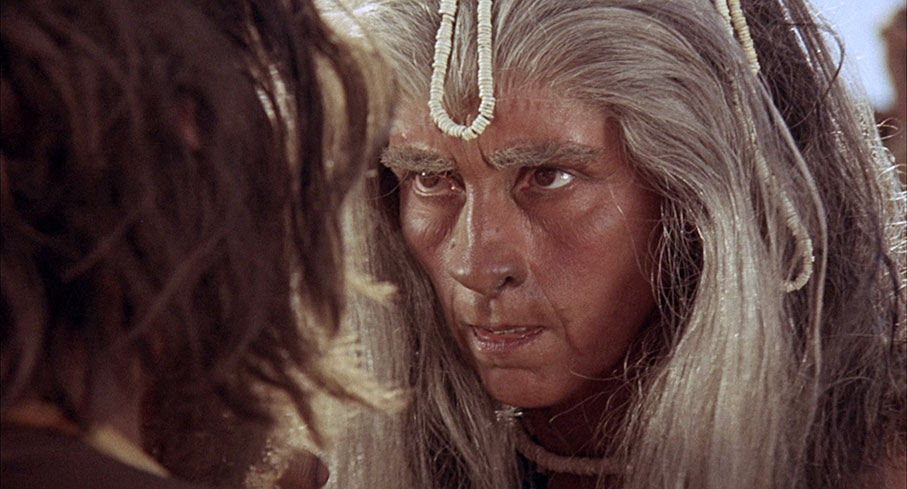
The Linear PCM 1.0 mono soundtrack is also in robust shape. Unsurprisingly, given the film's age, there are no low frequency bass rumbles when the volcano erupts, but the sound is otherwise clear, particularly the music and effects, and the track itself shows no signs of wear or damage.
And in case you were wondering, yes, optional English subtitles for the deaf and hearing impaired have been included. Watching the film with these enabled, I couldn't help thinking that whoever landed the task of creating them must have found this the least taxing of such jobs they've done for Indicator, given that subs only occasionally appear and consist largely of brief bracketed descriptions of actions, like "(Grunting)," "(Chattering)," "(Groaning)" or "(Sighing)." After the challenge of something like Peter Mullan's Orphans, this must have felt like a holiday.
Audio Commentary with Sean Hogan and Kim Newman
Filmmaker Sean Hogan and our old friend Kim Newman tackle a film that both were disappointed by in their younger days because it lacked the stop-motion dinosaurs of its predecessors, but now regard as an interesting and well-made work with standout elements. They're up front about the fact that this is not one of Hammer's more highly regarded films, with Newman suggesting jokingly that the reason he and Hogan are doing this commentary is because all of the real Hammer experts turned it down. As ever with any commentary in which Newman is able to bounce off a fellow genre enthusiast, the resulting discussion makes for enthralling listening, although there are a few brief spells of silence, at least one of which is sudden enough (it occurs mid-sentence) to suggest that something was snipped at the editing stage. Subjects covered include the borrowing of effects footage from One Million Years B.C., the landscape as a character in the film, the notion that the main story doesn't start until the halfway mark, elements that reflect the counterculture of the day, Don Chaffey's direction, Mario Nascimbene's score, the physical risks taken by the actors, the portrayal of primitive religion, and plenty more. It's noted that the film is aiming for more a realistic aesthetic than its predecessors, with individual scenes coming in for enthusiastic praise, and Hogan concludes, "Much as we may want more Ray Harryhausen, I'm glad we have this anyway."
Hammer's Women: Julie Ege (6:51)
A fact-driven skip through Norwegian actor Julie Ege's career, with particular focus on the films she made after Creatures the World Forgot. I have to admit to being unaware that she trained and qualified as a nurse when she retired from acting and returned to Norway, which lifted my spirits for my upcoming hospital visit.
Jonathan Rigby: Signs of Change (25:03)
Author of English Gothic: A Century of Horror Cinema 1897–2015 and Indicator regular Jonathan Rigby delivers a considerable amount of background information on what he describes up front as an extraordinary film, as well as an unusual one to emerge from the Hammer Studio. He takes us through the process of the film's production, from its typically Hammer beginnings as nothing more than a title and three posters, through various scripts to its eventual funding and production, and ultimately its release and less-than enthusiastic critical reception. He describes it as a strikingly good-looking and strikingly uncompromising film, and champions actor Brian O'Shaughnessy as the element that speaks most strongly of early man.
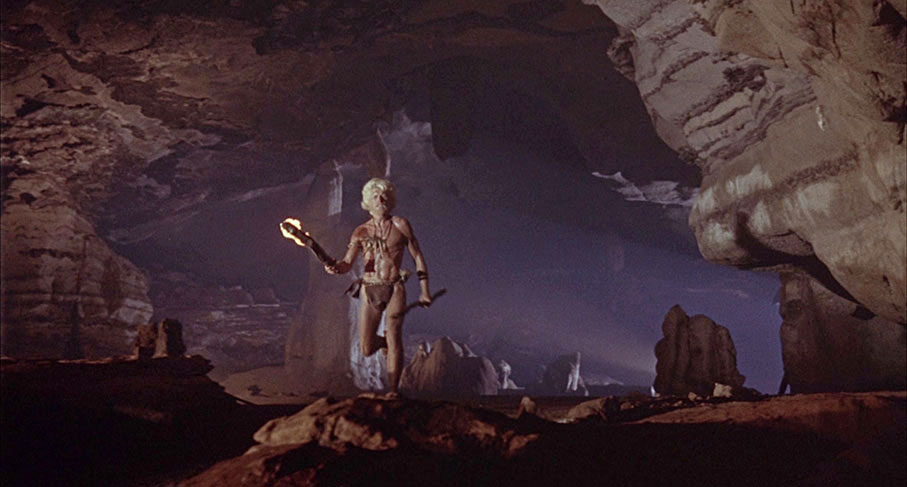
Primitive Rites: David Huckvale on Mario Nascimbene (26:06)
Another Indicator regular, film music expert David Huckvale, provides an overview of the career of composer Mario Nascimbene, before going on to deconstruct his score for Creatures the World Forgot. He admits to preferring this film to Quest for Fire, in part because he finds Nascimbene's score more interesting that the one composed by Philippe Sarde for Jean-Jacques Annaud's later prehistoric drama, and interestingly suggests that the battle between the two brothers in the film has a whiff of Kane and Abel about it.
Theatrical Trailer (2:14)
A rather slickly assembled American release trailer that encourages its potential audience to come along and "see their primitive mating rites" and "the ordeal of the virgins." Unsurprisingly, it makes "fabulous Norwegian beauty" Julie Ege its prime selling point.
TV Spot (1:02)
A cut-down version of the above, but one that really pushes the search for a new female star and the selection of Julie Ege, skipping through her press and portfolio pictures before turning its attention to the film in which she appears.
Radio Spot (0:50)
A serious voiced narrator, who hits the reverb button when saying the film's title, tells of "a world of brutal combat where women are spoils to the victors." Try going with that promotional angle nowadays and see where it gets you, matey.
There are two manually advanced Image Galleries. Promotional Materials boasts a lavish 105 screens of largely monochrome, high quality production stills. Behind the Scenes delivers on its promise, with 69 screens of the crew and actors at work, relaxing between takes, or posing for the camera (some of these were likely used for promotional purposes). Again, the majority of these are monochrome with a spattering of colour photos at the end, and all are of excellent quality.
Skid Kids (1953) (48:39)
Ah, the Children's Film Foundation. I spent my younger years watching the films it produced at Saturday morning pictures, which for those too young to remember was a weekly event where the local cinema screened a programme of short films and serials for children whose parents were doubtless glad to see the back of them for a couple of hours or so. We liked these films because the lead characters were roughly our age and from similar backgrounds (that some sounded as if they were slumming it from an upper middle class family never occurred to us at the time), and they would always resourcefully outwit the regulation dastardly adults. Parents and authority figures simply came along for the ride and to mop things up once the kids had done the detective work for them. Often presenting a rather idealised view of post-war working-class childhood, these were well made films whose continuing entertainment value today is matched by their very real value of records of a bygone Britain.
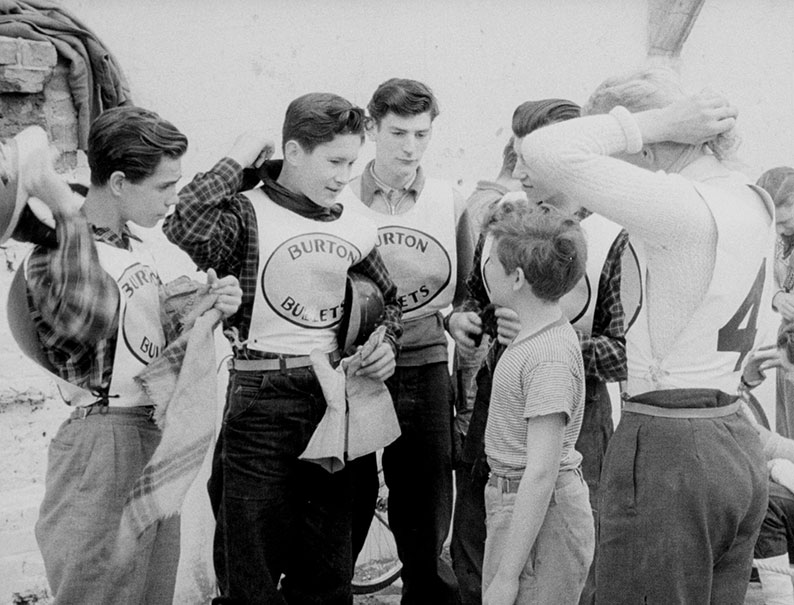
Directed by Don Chaffey, this early CFF film was long before my time, but it fits the above detailed formula to a tee. In working class southeast London, The Burton Bullets, a team of cycle speedway riders led by Swanky Clarke (Barry MacGregor), win the local semi-finals and are set to play the Bermondsey Greyhounds in the final. At the same time, two spivs named Spike (Lance Campbell) and Sam (Barry Phelps) are cruising the area in a van stealing any unattended bicycles they see, which they take to a shifty geezer named Joe, who does them up for them to sell. When excitable Italian artist Antonio (Kurt Wagener) has his bike stolen from outside his workplace, his boss Mr Johnson (Graham Stuart) suspects the local kids, and threatens to stop the Burton Bullets practising for the final on his land. Investigating the thefts, meanwhile, is well-liked local bobby Sergeant Scott (Peter Neil), who asks questions and listens attentively, but doesn't seem to do a whole lot to help.
If you've seen even a few CFF films from this era then you should be able to write much of the rest yourself, and even if you haven't then I'd still wager you could make a fairly accurate guess at how things subsequently unfold. But this matters little given a young target audience that would have lapped this up, and coming to the film with a decades of adulthood under my belt, I still enjoyed the hell out of it. Yes, there's a degree of nostalgia at play here, as much for these films as my own childhood years of improvised outdoor amusement, but Skid Kids is very smartly directed by Chaffey and handsomely photographed in crisp monochrome by wonderfully named cinematographer, S.D. Onions. A couple of brief studio scenes aside, the film was shot on actual southeast London locations with what looks like half the population of the area recruited as extras. Of the professional actors, my favourite has to be Vi Kaley, who plays an elderly women who pushes her way to the font of a gathered crowd when Spike and Sam stop to sell their stolen goods, then stares at them with a google-eyed expression that suggests she thinks they've both lost their minds. British movie stalwart A.E. Matthews even makes a guest appearance as a taxi passenger who loses his hat.
The film has clearly been restored, and despite a few minor remaining signs of wear, the image is sharp, and while the contrast does vary a little in places, for the most part it's nicely balanced, and the soundtrack is clear and free of damage. Optional English subtitles for the deaf and hearing impaired are provided for this film and the two CFF shorts detailed below.
Audio Commentary on Skid Kids with Vic Pratt
Film historian and self-confessed devotee of the films of the CFF, Vic Pratt, delivers a hugely engaging and educational commentary not just on the film, but the Children's Film Foundation as a whole and the locations on which the film was shot, which he reveals were almost all on the Number 42 bus route. We get information on the wartime origin of spivs, the birth of the independent teenager, how bicycles were once a status symbol for kids, the stock CFF characters and story elements, the locations, and lots more. I learned plenty here, including the fact that an old law allowed market traders of the day to sell stolen goods if they didn't know they were stolen. Great stuff.
A Good Pull-Up (1953) (17:31) and Watch Out! (1953) (17:56)
Two more CFF short films directed by Don Chaffey, both of which star Carry-On regular Peter Butterworth as Dickie Duffle, a self-proclaimed handyman who is so disaster prone that no-one with even an ounce of sense would allow him anywhere near their property. Seriously, if he came into your house to fix a dripping tap, within fifteen minutes the roof would probably fall in and the floor explode. The character apparently appeared in six comedy shorts for the CFF in the early 1950s, though only three of these are listed on Butterworth's IMDb page, these two included.

Both of the films here kick off with Dickie pushing a handcart down the street and encountering his young friend Tom (John Levitt), who then becomes sucked into the mayhem that subsequently unfolds. In A Good Pull-Up, Tom offers to help Dickie with his handcart, and the two pause their journey at a roadside café for a cup of tea, where Dickie's repeatedly frustrated efforts to get served soon descend into chaos. In Watch Out!, the contents of Dickie's cart take a tumble when Mr. Crossington (Humphrey Kent, who also plays the café boss in A Good Pull-Up), the pompous studio manager of a local film company, hassles him to get out of the road so he can get to work, in the process dropping his watch, which Dickie then makes increasingly disastrous efforts to return.
Both films are essentially silent slapstick comedies with added dialogue, with a dash of early twentieth century music hall comedy thrown in. This has inevitably both dated the films and given some elements a slightly second-hand feel, with routines designed by Butterworth recalling similar ones by the likes of Charlie Chaplin, Laurel and Hardy, the Keystone Cops, the Marx Brothers, and more. The formula for both films is straightforward enough, simply requiring Dickie to enter a smoothly functioning business, either openly or sneakily, and then trigger an increasing level of chaos by acting without thinking and doing idiotic things. I've no doubt that the target audience of the day lapped this up, and if your comedy tastes are so inclined, these are as crammed with slapstick mayhem as you could wish for, and Butterworth certainly commits himself here. For me, they definitely proved to be of interest – particularly for the look inside the real Nettlefold film studio in Watch Out! – and while the sometimes heavily telegraphed and over-familiar physical gags failed to make me laugh, I never felt the urge to fast-forward or check my email whilst watching.
While Watch Out! has been impressively restored, The Great Pull-Up is in less sparkling shape, having a slightly softer picture, a higher number of very visible scratches and dust spots, and a hum on the soundtrack for the opening few seconds. This is likely down to the source material (it's suggested on the commentary that this might have been taken from a 16mm rather than 35mm print), and is still in decent shape otherwise and very watchable.
Audio Commentary on A Good Pull-Up and Watch Out! with Vic Pratt
Vic Pratt once again provides enthusiastic and informative commentaries for both films, and while he is every bit as passionate about these shorts as he is about Skid Kids, I did get the impression that he's a little less confident that others might share his opinion, hence his repeated suggestion that we have to suspend our disbelief and even put our critical faculties on hold to really enjoy them. Maybe he's right. Both commentaries are an engaging blend of observation, opinion, and background details, with an acknowledgement of the influence of silent and early sound era comedians, recognition of the risky nature of some of the stunts, and the revelation that as a prisoner of war, Peter Butterworth was one of the men involved in the famed wooden horse escape from Stalag Luft III. One thing to note is that although the films themselves are listed on the special features menu in the order noted above, with The Great Pull-Up followed by Watch Out!, when listening to the commentaries it's a good idea to reverse this, as Pratt clearly recorded his commentary for Watch Out! first and makes reference to it in the commentary for The Great Pull-Up.
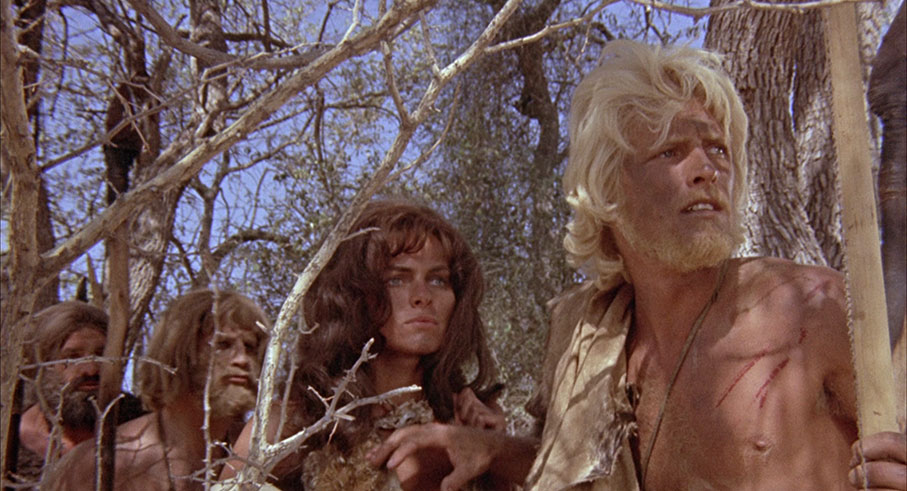
Limited Edition 80-Page Book
Following the full film credits, the lead essay here is by author Julian Upton, who while light-heartedly critical of the film's weaker elements, also nails some of the things that lend it a degree of unexpected longevity, concluding wittily that, "in the Lost World of Hammer's prehistoric films, it does pack the most convincing punch." Biographies of the lead actors from the film's promotional materials are followed by a May 1970 piece from the Salt Lake Tribune about the search for 'the next Rachel Welch'. The eventual selection of former Miss Norway, Julie Ege, is covered in a story from Statesville Record and Landmark, while Ege herself is interviewed in a piece from the Arizona Daily Star. A couple of brief pieces on director Don Chaffey lead into a fun section featuring promotional suggestions from Columbia's press materials, including some dated ideas built around Julie Ege's figure, and the eye-widening Freudianism of the tagline, "Staked girl menaced by giant python!" Steady on. There's a sizeable pressbook piece on writer-producer Michael Carreras, and an article from the Chicago Tribune in which Gene Siskel interviews Hammer's financial wizard Roy Skeggs about the company's recipe for success and its future plans. I wasn't completely surprised when the extracts from contemporary reviews kick off with complaints in Monthly Film Bulletin about the lack of creatures, but this is followed by more positive responses to the film by Howard Thompson of the New York Times and (especially) Kevin Thomas of the Los Angeles Times. Finally, we have credits for Skid Kids, A Good Pull-Up and Watch Out! and a welcome piece on Don Chaffey at the CFF by Jeff Billington.
As is made clear in the special features, Creatures the World Forgot was for years a poorly regarded and even forgotten Hammer title that nowadays is ripe for re-evaluation. Nobody's going to claim that this is an accurate portrait of the prehistoric era and early tribal culture, but it's far more grounded in a recognisable reality than its admittedly entertaining and more colourful predecessors. Indicator's Blu-ray is once again top-notch, with a strong transfer and some excellent special features, with the CFF films and Vic Pratt's enthusiastic commentaries the most unexpected bonus here. Some may still scoff at the film itself, but as a package, it's hard to find fault. Warmly recommended.
|